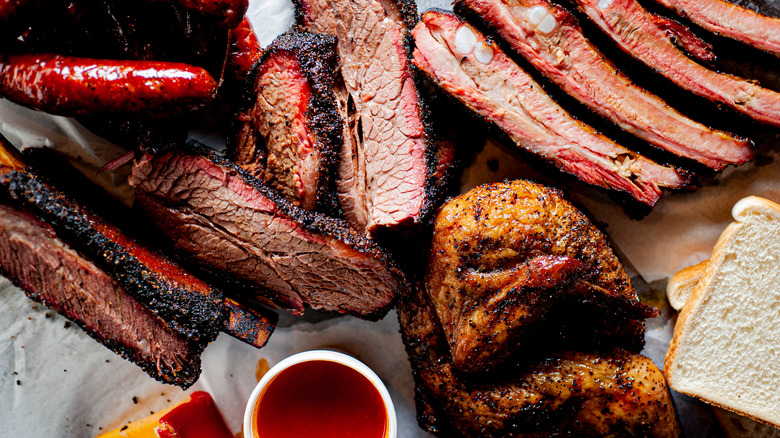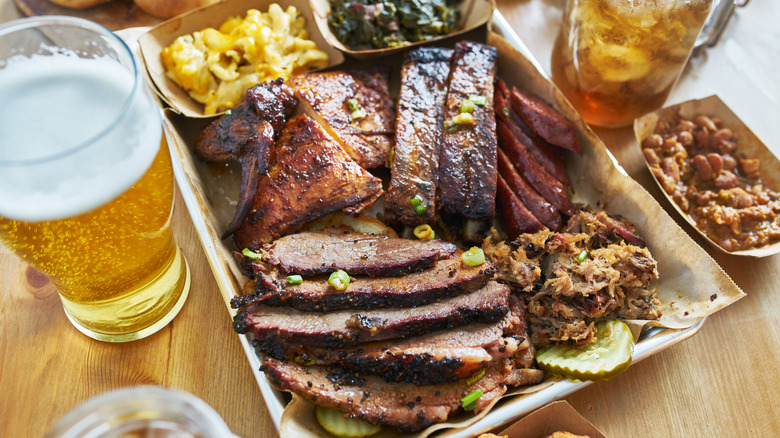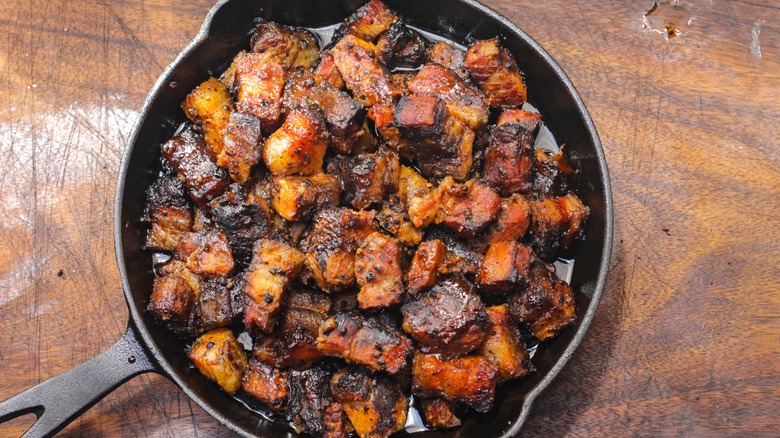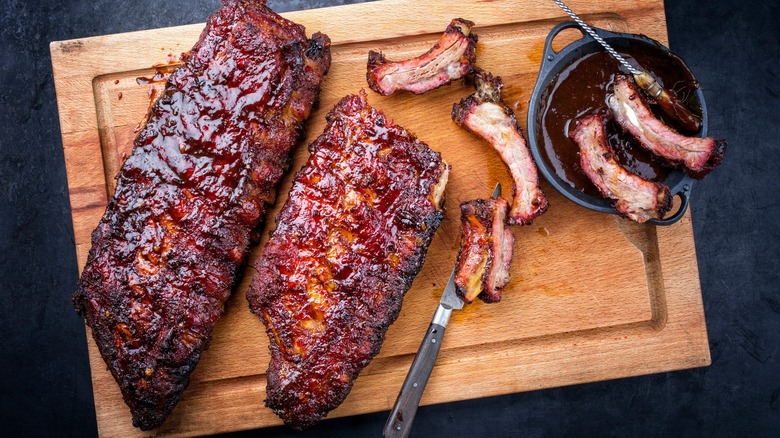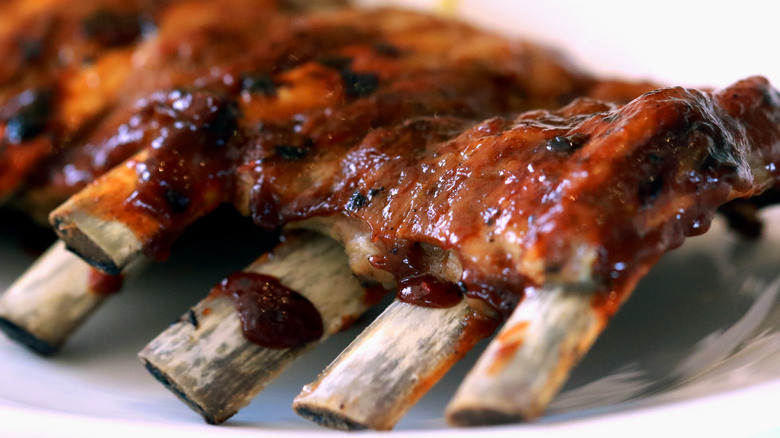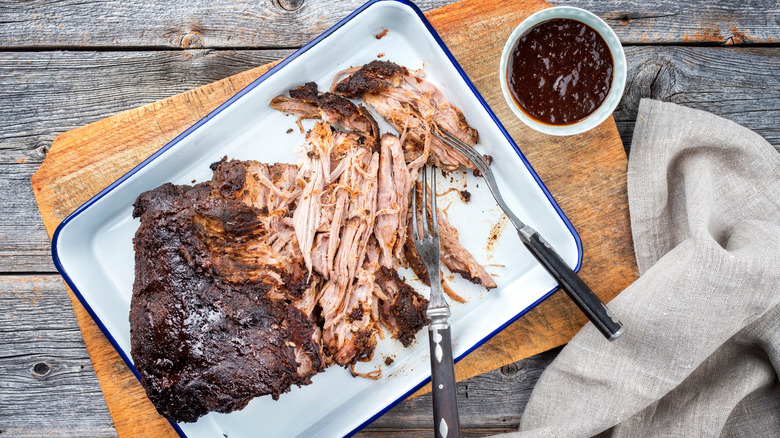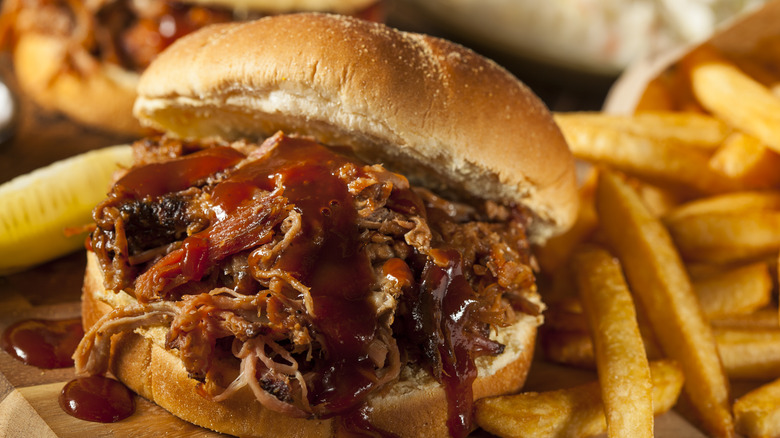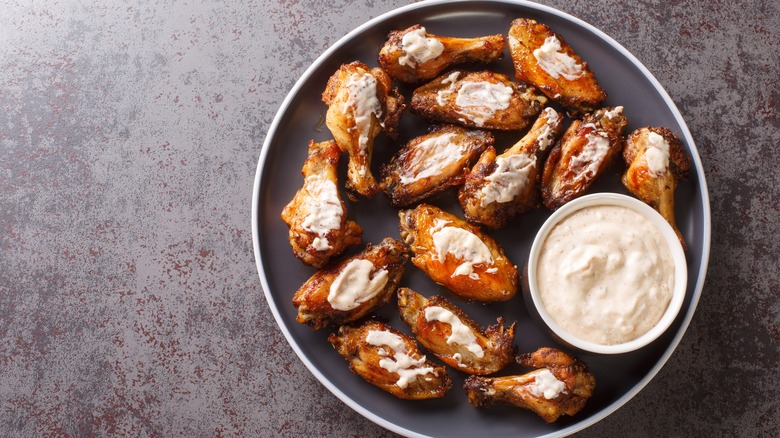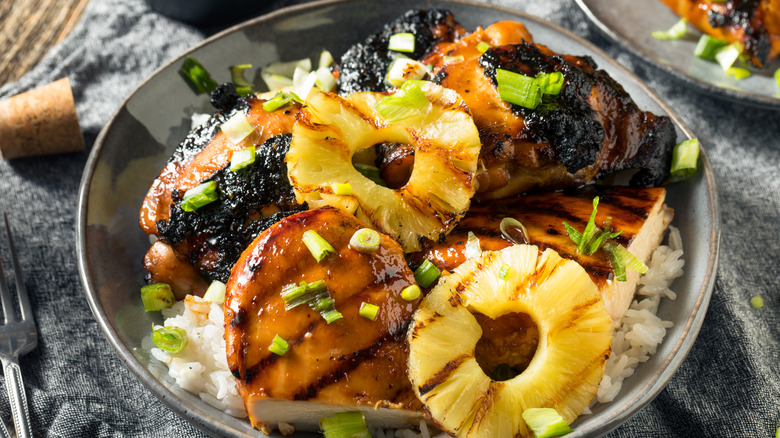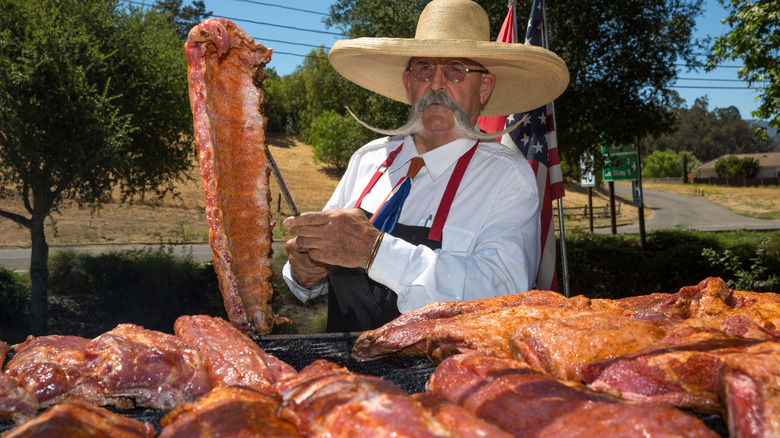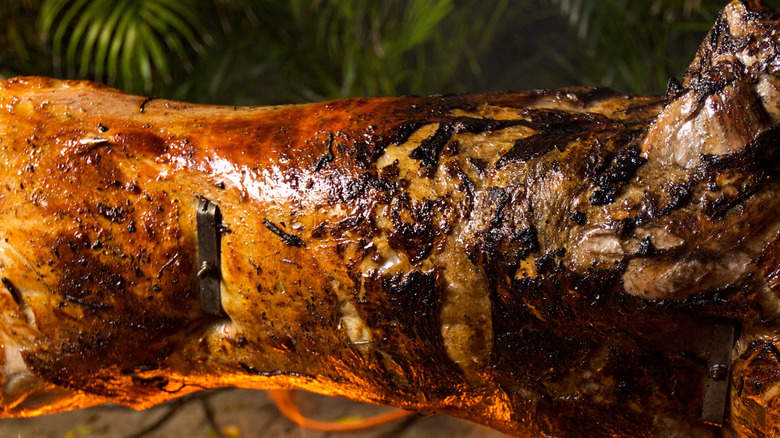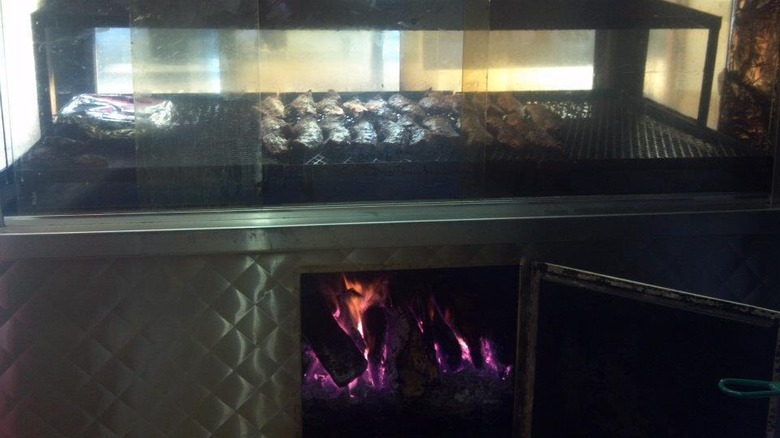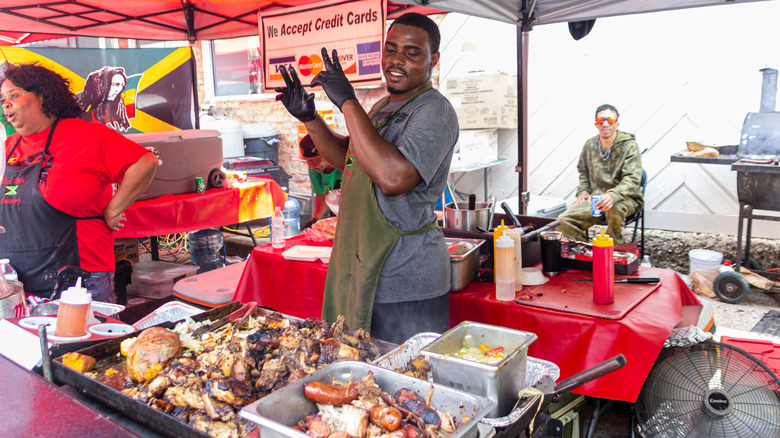Spilling The Beans On Every Style Of American BBQ
Barbecue is as American as apple pie in that ironically neither originates in the United States. In the true heart of what makes America a great country, both barbecue and apple pie originated with settlers. Those settlers shared their cultures and foods, and made the flavors and recipes uniquely their own. For some regions, barbecue originates in the Caribbean, where they smoked an entire pig low and slow in a pit. In some states barbecue originated with Native Americans who taught settlers methods of pit cooking meats over grates.
People tend to think barbecue is as southern as Scarlet O'Hara in her giant beribboned hat eating "bau-bea-que" with all the beaus in the county. While it is true barbecue is a southern tradition, one of the defining parts of barbecue is it also has a long, somewhat contentious history.
Part of the ongoing conflict by barbecue lovers are questions like, "Is grilling considered barbecue?" They might also question whether or not gas can be used to cook barbecue. True aficionados say a hearty "no!" to both of these. Others argue which meat reigns supreme, or what constitutes the best sauce. One thing most everyone can agree on is no matter how you define it, barbecue is delicious. The magic of good barbecue is it brings people together across the United States to enjoy amazing food — no matter which style you're eating.
Texas Style BBQ
In the state where everything bigger is better, barbecue is no exception. While pit smoked brisket is the most common in Texas, there are actually four types of Texas barbecue. Pitmasters love to slow smoke massive slabs of brisket with dry rub is king in Central Texas — and they blend hickory, mesquite and/or oak infuses meat with beautiful flavors. You don't make sandwiches with this meat. Instead, the traditional method of delivery is meat sliced thick as you watch before piling everything onto parchment paper.
East and Central Texas styles may look similar, both areas using low and slow styles of cooking, but East Texas cooks more pork. If you love sides, East Texas has you covered. Heavily influenced by Southern cooking, okra, banana pudding and, the Creole classic boudin find homes on East Texas plates.
While you can still find beef in West Texas Style barbecue, open fire grilling is what defines this area's style. Since the meat is grilled on open flames, the cooking time is faster. Meats like chicken, ribs, and sausage cooked over mesquite are common.
Finally, South Texas flavors go south of the border with their Mexican inspired flavors. In South Texas, barbacoa, asada, and carnitas are at home alongside slow-smoked brisket and creamed corn. Meats like goat, lengua (tongue), and cheek are first wrapped in agave leaves. These bundles of tastiness are left overnight in deep pits over coals to create delicious, juicy and tender dishes.
Kansas City Style BBQ
Kansas City is best known for their barbecue sauces for good reason. Their traditionally tomato-based sauces are delicious combinations of spicy and sweet, often made with molasses, brown sugar and apple cider vinegar. You can create your own tasty variation and see what we mean.
Kansas City barbecue sops their sauces over meat that has been dry-rubbed, then grilled. While brisket is at home in Kansas City, the area welcomes fish, whole chicken, and ribs to their grills. We've been told the best barbecue dish in the Twin City is charred or burned pork burnt ends.
Kansas City takes their barbecue seriously. Self-proclaimed "King of Barbecue," pitmaster and restaurateur, Henry Perry is considered the first person to truly earn a living selling barbecue. Perry, a black man who sold smoked meats and a "peppery" sauce is also credited with breaking racial barriers. He sold his hickory smoked, newspaper wrapped meat to any customers for 25 cents. Perry is an integral part of KC barbeque and the city keeps that history alive. The Kansas City Barbeque Society says they are "the world's largest organization of barbeque and grilling enthusiasts." With more than 16,000 members, and sanctioning, producing, or volunteering for more than 300 barbecue events, the KCBS helps keep the hearts and grills of barbecue burning.
St. Louis Style BBQ
While Kansas City and St. Louis styles may seem similar and are commonly compared, their styles of barbecue have differences. Both areas are pork-centered, especially when it comes to ribs. What makes the two styles unique is the cuts of their ribs, specifically how the meat is trimmed. Both regions use spare ribs, but St. Louis style means the cartilage, sternum bone, and rib tips have been removed. This trimming results in a rectangular shape, allowing for more even cooking. St. Louis is also about pork steaks, and pig snouts known as "crispy snoots."
The other reason St. Louis and Kansas City are considered similar is because of their sauces. Both are tomato-based, but once you pour and taste each style, you'll quickly see the difference. Saint Louis sauce is considered thinner and not as sweet due to small quantities of vinegar and less sugar in the recipe. If you want to put sauce on your meat as it's grilling, St. Louis' less sugary combinations are the way to grill without as much risk of burning as opposed to more sugary counterparts.
Memphis Style BBQ
You won't be singing the blues if you get some delicious Memphis style barbecue. Memphis, Tennessee barbecue is all about the pork — specifically pork shoulder and ribs, all coated with a seasoned dry rub. The Memphis rub can be complex, sometimes using up to 40 spices. Memphis rubs always use a base of salt, pepper, brown sugar, garlic, and paprika. The blending of flavors in a good dry rub is part of what makes each pitmaster's rub special.
What makes Memphis barbecue different, aside from their blending of rub seasoning, is their barbecue sauce. While Memphis uses tomato-based sauce like many other regions, Memphis style tends to be thinner than Texas style or even Kansas City. In Memphis, the sauce will often include mustard and vinegar, lending the sauce a thinner, tangier taste.
Since Memphis style sauce has less sugar than its Texas counterparts, pitmasters will slather the meat with sauce as it cooks. Putting barbecue sauce on during cooking allows the meat to become deliciously caramelized, meaning a tasty crusty layer. While the pulled pork sandwich is king, don't limit yourself! If you're in Memphis, try out Payne's Bar-B-Q smoked baloney sandwich for a true Southern treat!
North Carolina Style BBQ
You may wonder why the Carolinas have separate entries on our list. This is because there are significant differences in barbecue styles. In North Carolina, the differences between the two regions' styles has even become a matter of state legislature. The Carolinas take their barbecue very seriously, especially between the two areas. Not knowing the difference has caused well-meaning politicians to get raked over the coals in the Carolinas.
According to John and Dale Reed, authors of "Holy Smoke: The Big Book of North Carolina Barbecue," North Carolina barbecue must meet three qualifications: The meat must be barbecued, meaning cooked at a low temperature for a long time with heat and smoke flavoring the meat from a fire of hardwood and/or hardwood coals. And the meat must be pork (whole hog, shoulder, or occasionally ham). Finally, the meat is always served with a thin vinegar-based sauce.
While you may find variations in the state, these three main principles are what makes North Carolina barbecue stand apart from other localities. True Tarheel barbecue enthusiasts may enjoy brisket — or different sauces — but those aren't "real" barbecue.
South Carolina Style BBQ
Not only does North and South Carolina have distinct differences in their barbecue styles, but South Carolina further divides their flavors and styles. The major difference between the two states is about the sauce. While North Carolina is all about a vinegar-based sauce, South Carolina goes a step further. They embrace four different flavors of barbecue sauce: mustard, heavy tomato, light tomato, and vinegar.
The mustard sauce is found primarily toward the coastline in the midland part of the state and is credited as originating from German settlers. A heavy tomato based sauce is the favorite of the northwestern and western parts of South Carolina, whereas a light sauce is mostly found in the upper part of the state. Finally, the spicy vinegar/pepper based barbecue sauce finds a place along the coast.
In North Carolina, they are about pork. South Carolina agrees, but similar to their sauces they go the extra mile. In South Carolina, they go whole hog. We literally mean they cook entire pigs low and slow.
To be true South Carolina barbecue, the pork must be up on a grate. While this may look like grilling, this style (called barbacoa in South Carolina) differs from other areas. In Mexico and other southern areas like Texas, barbacoa means pit smoking and grilling. Raised grates allow the meat to cook over hardwood coals and is still low and slow in regards to cook times. This style of pit smoking is one of the hotly debated, and crucial distinctions of South Carolina style barbecue.
Alabama Style BBQ
Alabama joins the barbecue belt — the southern regions considered the primary players of barbecue like Texas, the Carolinas, Memphis and Kansas City who utilize low and slow cooked meat. Like the Carolinas and Memphis, pork is the specialty in Alabama. You'll mostly find pork butt or shoulder, ribs, and sometimes ham — however, beef ribs, brisket and chicken are also welcome on Alabama's grills.
While there are similarities to the other barbecue territories, Alabama tweaks things a bit. Alabama pitmasters use pecan, hickory, or oak woods to smoke their pork. In eastern Alabama, you can find South Carolina's influence with mustard in a spicy sauce, or the North Carolina influenced vinegar sauce.
But Alabama has a special sauce that earns them a place on our list — because the biggest difference is their sauce. If you're not familiar with Alabama style barbecue, their sauce might be a surprise if you think barbecue sauces are always red tomato or vinegar based. Alabama's sauce is white. Like an aioli, the sauce is mayonnaise forward, blended with apple cider vinegar, mustard and seasonings.
Made famous by Big Bob Gibson's Bar-B-Q, the restaurant first used their white sauce "baptizing" their chicken to prevent drying out while sitting on the grill. The sauce made its way tableside where customers squirt Big Bob's sauce on their pork sandwiches. A legend and a controversy was born. White sauce as a pizza sauce with grilled chicken is magical!
Hawaiian Style BBQ
Perfect for summer, Hawaiian style barbecue differs from other states because their marinades and sauces are inspired by Asian flavors. The Aloha state uses soy sauce, fruit juices like pineapple, or sesame oil as part of their marinades. This is a huge difference to most other American tomato or vinegar barbecue sauce foundations, and one of the distinctly unique Hawaiian flavors.
The sauces in the continental states are heavily influenced by Spanish explorers, Native Americans, and German settlers — whereas Hawaiian barbecue is influenced by Asian and other Pacific island flavors. One of the most popular and delicious flavors is Huli Huli sauce — a combination of soy sauce, pineapple juice, brown sugar, garlic, honey, and ginger. This sauce is brushed on the meat during grilling, creating a sweet, caramelized crust. Huli Huli style barbecue is considered more informal, something you find at roadside stands or tasty little local joints.
The other style of Hawaiian barbecue is the luau which is a more grand occasion like a wedding or large celebrations. At a luau, a whole pig is cooked in an imu pit – the finished Kalua pork being one of the most delicious, succulent meat you've ever had.
California Style BBQ
In California, Santa Maria-Style barbecue is the most common or popular style of barbecue. What sets Santa Maria-Style apart is primarily the meat. True Santa Maria barbecue starts with a top-block sirloin or tri-tip. Originally Santa Maria-style barbecue started with ranchers who would have a giant feast after a cattle round up. The key to this California style barbecue is the use of the state's native red oak, also known as coast live oak.
Another major difference in California style barbecue, or Santa Maria barbecue is the cooking method. Whereas the bulk of the other regions use low and slow, indirect heat with hardwood coals, California does things differently. When using a Santa Maria style grill, the heat is hot and fast. Because both cuts of beef have quick cooking times is why tri-tip or top-block is used. You also don't get the char or smoky flavors as the more "traditional" slow cooked meats.
Largely influenced by Mexican flavors and barbacoa style cooking methods and flavors, California barbecue encompasses a delicious blending of cultural flavors. In the south, you typically find sides like cornbread, fried okra, potato salad, and creamed corn. In the Sunshine State, you'll still find creamed corn but it might be grilled elote or Mexican Street corn – or your tri-tips will have a delicious corn salsa.
Kentucky Style BBQ
Kentucky style barbecue is another outlier on our list, and often not considered when talking about the "big" players like Kansas City or Texas. But this is an oversight — Kentucky has three barbecue styles. Owensboro County along with several other western Kentucky counties focus around mutton. Historically, sheep farmers in Western Kentucky found themselves with too many animals past their wool producing prime. In an effort to use the older stock, the ranchers came up with a tasty solution.
Since the sheep were also past the point where their meat was tender, the answer was to break down the meat. The mutton quarters were basted while cooking with a thin Worcestershire sauce-based dip, called "mutton dip." This blend of vinegar, lemon juice, Worcestershire, and spices not only breaks the meat down, but adds an amazing flavor.
Restaurants and ranchers who cook mutton don't use old animals, instead producing sheep specifically for their meat. Not all of Kentucky is about mutton, however. The Western counties prefer pork shoulders or butt, smoke cured hams and turkey breasts using hickory coals. Another uniquely Kentucky recipe is the oft-overlooked Monroe County style. The pork shoulder is frozen, then using a meat saw, the meat is thinly sliced with the bone in. These slices are cooked on a grate over hot coals for about four minutes. The slices are also basted with a spicy Monroe County vinegar dip.
Chicago Style BBQ
When you think of Chicago style food, odds are good Chicago style hotdogs or pizza come to mind. While that's true, the area also has their own barbecue. Historically, the Windy City style barbecue was born out of necessity. The Chicago Union Stockyard was a major distributor of live animals in the late 1800s — and by 1920, became an epicenter for butchery.
Rib tips, similar to pork belly, were a discarded cut of beef from the shorter side of the ribs. Since rib tips still have cartilage and are a tougher cut of meat, they were thrown out by many of the area's butchers. Pitmasters in Chicago's South Side saw this opportunity and used the low and slow method to make delicious, tender rib tips. In an example of black entrepreneurship, these pitmasters not only took a discarded cut of meat, but introduced the aquarium smoker which is a difficult type of pit smoking to use.
In 1954, Avenue Metal developed what has now become a defining South Chicago barbecue staple, creating the temperamental, difficult-to-use aquarium smoker. Aquarium smokers look like the name implies — a tempered glass and steel pit that looks like a giant aquarium. While these smokers are difficult to use because they are labor intensive, the pitmasters who use them are true masters of 'cue.
Georgia Style BBQ
While much of the debate regarding barbecue is about which meats or woods are best, using sauce or not, what types of sauces, and so forth, the "big" barbecue areas have styles distinctly their own. But barbecue in Georgia actually does not have a precise style and is not emphatic about which meats or woods they use — and this is what makes Georgia barbecue special. It's all in the Georgia pitmaster's attitude about barbecue.
The ruling concept is that barbecue should be accessible for everyone to enjoy. Harrison Sapp, co-owner and pitmaster of Southern Soul Barbeque, says Georgia barbecue is "more about what locals want, rather than strict standards for smoking and sauce-making" (via Eater). This desire to create flavors for the people who truly love barbecue — the locals and not competitions or awards — is what sets Georgian barbecue apart. In Georgia, pitmasters take the elements that make barbecue delicious and give the people what they want.

